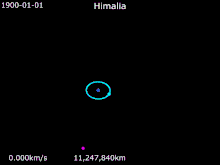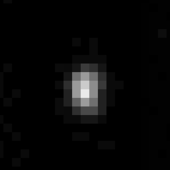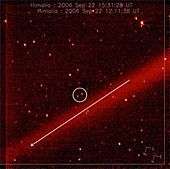Himalia (moon)
Himalia /hɪˈmeɪliə/, or Jupiter VI, is the largest irregular satellite of Jupiter, with a diameter of at least 140 km (90 mi).[5] It is the fifth largest Jovian satellite, after the four Galilean moons. It was discovered by Charles Dillon Perrine at the Lick Observatory on 3 December 1904 and is named after the nymph Himalia, who bore three sons of Zeus (the Greek equivalent of Jupiter).[1] It is one of the largest planetary moons in the Solar System not imaged in detail, and the largest within the orbit of Neptune.[lower-alpha 2]
 Himalia as seen by spacecraft Cassini | |
| Discovery [1] | |
|---|---|
| Discovered by | Charles D. Perrine |
| Discovery site | Lick Observatory |
| Discovery date | 3 December 1904 |
| Designations | |
Designation | Jupiter VI |
| Pronunciation | /hɪˈmeɪliə/ or /hɪˈmɑːliə/[2] |
Named after | Ἱμαλία Himalia |
| Adjectives | Himalian[3] |
| Orbital characteristics [4] | |
| Epoch 27 April 2019 (JD 2458600.5) | |
| Observation arc | 114.32 yr (41,728 d) |
| 0.0761287 AU (11,388,690 km) | |
| Eccentricity | 0.1537860 |
| 3.545 yr (248.29 d) | |
Average orbital speed | 3.312 km/s |
| 94.30785° | |
| 1° 26m 59.616s / day | |
| Inclination | 29.90917° (to the ecliptic) |
| 44.99935° | |
| 21.60643° | |
| Satellite of | Jupiter |
| Group | Himalia group |
| Physical characteristics | |
| Dimensions | 205.6 × 141.4 km (stellar occultation)[5] 150±20 × 120±20 km (Cassini estimate)[6] |
Mean diameter | 170 km (ground-based estimate)[7][6] |
| ~ 91000 km2 | |
| Volume | ~ 2600000 km3 |
| Mass | (4.2±0.6)×1018 kg[8] |
Mean density | 2.6 g/cm3 (assumed)[7] 1.63 g/cm3 (assuming radius 85 km)[8][lower-alpha 1] |
| ~ 0.062 m/s2 (0.006 g) | |
| ~ 0.100 km/s | |
| 7.782 h[9] | |
| Albedo | 0.04[7][6] |
| Temperature | ~ 124 K |
| 14.6[7] | |
| 7.9[4] | |
Discovery
Himalia was discovered by Charles Dillon Perrine at the Lick Observatory on 3 December 1904.[1] Himalia is Jupiter's most easily observed small satellite; though Amalthea is brighter, its proximity to the planet's brilliant disk makes it a far more difficult object to view.[10][11]
Name
Himalia is named after the nymph Himalia, who bore three sons of Zeus (the Greek equivalent of Jupiter). The moon did not receive its present name until 1975;[12] before then, it was simply known as Jupiter VI or Jupiter Satellite VI, although calls for a full name appeared shortly after its and Elara's discovery; A.C.D. Crommelin wrote in 1905:
Unfortunately the numeration of Jupiter's satellites is now in precisely the same confusion as that of Saturn's system was before the numbers were abandoned and names substituted. A similar course would seem to be advisable here; the designation V for the inner satellite [Amalthea] was tolerated for a time, as it was considered to be in a class by itself; but it has now got companions, so that this subterfuge disappears. The substitution of names for numerals is certainly more poetic.[13]
The moon was sometimes called Hestia, after the Greek goddess, from 1955 to 1975.[14]
Orbit

Jupiter · Himalia · Callisto
At a distance of about 11,400,000 km (7,100,000 mi) from Jupiter, Himalia takes about 250 Earth days to complete one orbit around Jupiter.[15] It is the largest member of the Himalia group, which are a group of small moons orbiting Jupiter at a distance from 11,400,000 km (7,100,000 mi) to 13,000,000 km (8,100,000 mi), with inclined orbits at an angle of 27.5 degrees to Jupiter's equator.[16] Their orbits are continuously changing due to solar and planetary perturbations.[17]
Physical characteristics

Himalia's rotational period is 7 h 46 m 55±2 s.[9] Himalia appears neutral in color (grey), like the other members of its group, with colour indices B−V=0.62, V−R=0.4, similar to a C-type asteroid.[18] Measurements by Cassini confirm a featureless spectrum, with a slight absorption at 3 μm, which could indicate the presence of water.[19]
Resolved images of Himalia by Cassini have led to a size estimate of 150 km × 120 km (93 mi × 75 mi), while ground-based estimates suggest that Himalia is large, with a diameter around 170 km (110 mi).[6][7] In May 2018, Himalia occulted a star, allowing for precise measurements of its size.[5] The occultation was observed from the US state of Georgia.[5] From the occultation, Himalia was given a size estimate of 205.6 km × 141.3 km (127.8 mi × 87.8 mi), in agreement with earlier ground-based estimates.[5]
Mass
In 2005, Emelyanov estimated Himalia to have a mass of (4.2±0.6)×1018 kg (GM=0.28±0.04), based on a perturbation of Elara on July 15, 1949.[8] JPL's Solar System dynamics web site assumes that Himalia has a mass of 6.7×1018 kg (GM=0.45) with a radius of 85 km.[7]
Himalia's density will depend on whether it has an average radius of about 67 km (geometric mean from Cassini)[8] or a radius closer to 85 km.[7]

| Source | Radius km | Density g/cm³ | Mass kg |
|---|---|---|---|
| Emelyanov | 67 | 3.33 | 4.2×1018 |
| Emelyanov | 85 | 1.63[lower-alpha 1] | 4.2×1018 |
| JPL SSD | 85 | 2.6 | 6.7×1018 |
Exploration
In November 2000, the Cassini spacecraft, en route to Saturn, made a number of images of Himalia, including photos from a distance of 4.4 million km. Himalia covers only a few pixels, but seems to be an elongated object with axes 150±20 and 120±20 km, close to the Earth-based estimations.[6]
In February and March 2007, the New Horizons spacecraft en route to Pluto made a series of images of Himalia, culminating in photos from a distance of 8 million km. Again, Himalia appears only a few pixels across.[20]
Possible relationship with Jupiter's rings

The small moon Dia, 4 kilometres in diameter, had gone missing since its discovery in 2000.[21] One theory was that it had crashed into the much larger moon Himalia, 170 kilometres in diameter, creating a faint ring. This possible ring appears as a faint streak near Himalia in images from NASA's New Horizons mission to Pluto. This suggests that Jupiter sometimes gains and loses small moons through collisions.[22] However, the recovery of Dia in 2010 and 2011[23] disproves the link between Dia and the Himalia ring, although it is still possible that a different moon may have been involved.
See also
- Irregular satellites
Notes
- Density = GM / G / (Volume of a sphere of 85km) = 1.63 g/cm3
- It is the largest with the exception of some of the moons of Neptune and several trans-Neptunian objects, particularly Dysnomia, the moon of Eris.
References
-
Porter, J.G. (1905). "Discovery of a Sixth Satellite of Jupiter". Astronomical Journal. 24 (18): 154B. Bibcode:1905AJ.....24..154P. doi:10.1086/103612.;
Perrine, C.D. (1905-01-25). "Sixth Satellite of Jupiter Confirmed". Harvard College Observatory Bulletin. 175: 1. Bibcode:1905BHarO.175....1P.;
Perrine, C.D. (1905). "Discovery of a Sixth Satellite to Jupiter". Publications of the Astronomical Society of the Pacific. 17 (100): 22–23. Bibcode:1905PASP...17...22.. doi:10.1086/121619.;
Perrine, C.D. (1905). "Orbits of the sixth and seventh satellites of Jupiter" (PDF). Astronomische Nachrichten. 169 (3): 43–44. Bibcode:1905AN....169...43P. doi:10.1002/asna.19051690304. - Daintith & Gould (2006) The Facts on File Dictionary of Astronomy, p. 216
- Yenne (1987) The Atlas of the Solar System.
- "M.P.C. 115889" (PDF). Minor Planet Circular. Minor Planet Center. 27 August 2019. Retrieved 27 February 2020.
- N. Smith; R. Venable (12 May 2018). "Jupiter (06) Himalia". www.asteroidoccultation.com. Retrieved 23 July 2018.
- Porco, Carolyn C.; et al. (March 2003). "Cassini Imaging of Jupiter's Atmosphere, Satellites, and Rings". Science. 299 (5612): 1541–1547. Bibcode:2003Sci...299.1541P. doi:10.1126/science.1079462. PMID 12624258.
- "Planetary Satellite Physical Parameters". JPL (Solar System Dynamics). 2008-10-24. Retrieved 2008-12-11.
- Emelyanov, N.V. (2005). "The mass of Himalia from the perturbations on other satellites" (PDF). Astronomy and Astrophysics. 438 (3): L33–L36. Bibcode:2005A&A...438L..33E. doi:10.1051/0004-6361:200500143.
- Pilcher, Frederick; Mottola, Stefano; Denk, Tilmann (2012). "Photometric lightcurve and rotation period of Himalia (Jupiter VI)". Icarus. 219 (2): 741–742. Bibcode:2012Icar..219..741P. doi:10.1016/j.icarus.2012.03.021.
- "Himalia, Jupiter's "fifth" moon". October 2009. Archived from the original on July 19, 2011.
- Rick Scott (October 20, 2003). "Finding Himalia, The Fifth Brightest Moon Of Jupiter". Astronomy.net. Retrieved 2011-11-07.
- Marsden, B. G. (7 October 1975). "IAUC 2846: N Mon 1975 (= A0620-00); N Cyg 1975; 1975h; 1975g; 1975i; Sats OF JUPITER". Central Bureau for Astronomical Telegrams. IAU. Retrieved 2018-09-09.
- Crommelin, A. C. D. (March 10, 1905). "Provisional Elements of Jupiter's Satellite VI". Monthly Notices of the Royal Astronomical Society. 65 (5): 524–527. Bibcode:1905MNRAS..65..524C. doi:10.1093/mnras/65.5.524.
- Payne-Gaposchkin, Cecilia; Katherine Haramundanis (1970). Introduction to Astronomy. Englewood Cliffs, N.J.: Prentice-Hall. ISBN 978-0-13-478107-5.
- "Himalia". Solar System Exploration. NASA. December 5, 2017. Retrieved 2018-09-09.
- Jewitt, David C.; Sheppard, Scott & Porco, Carolyn (2004). "Jupiter's Outer Satellites and Trojans" (PDF). In Bagenal, F.; Dowling, T. E. & McKinnon, W. B. (eds.). Jupiter: The planet, Satellites and Magnetosphere. Cambridge University Press.
- Jacobson, R. A. (2000). "The orbits of outer Jovian satellites" (PDF). Astronomical Journal. 120 (5): 2679–2686. Bibcode:2000AJ....120.2679J. doi:10.1086/316817.
- Rettig, T. W.; Walsh, K.; Consolmagno, G. (December 2001). "Implied Evolutionary Differences of the Jovian Irregular Satellites from a BVR Color Survey". Icarus. 154 (2): 313–320. Bibcode:2001Icar..154..313R. doi:10.1006/icar.2001.6715.CS1 maint: ref=harv (link)
- Chamberlain, Matthew A.; Brown, Robert H. (2004). "Near-infrared spectroscopy of Himalia". Icarus. 172 (1): 163–169. Bibcode:2004Icar..172..163C. doi:10.1016/j.icarus.2003.12.016.
- Lakdawalla, E. (1 March 2007). "The Bruce Murray Space Image Library - Jupiter's moon Himalia". Retrieved 17 November 2018.
- "Long Lost Moon of Jupiter Found". Carnegie Science | DTM. May 13, 2013. Retrieved 2018-09-09.
- "Lunar marriage may have given Jupiter a ring". New Scientist. March 20, 2010. p. 16.
- Gareth V. Williams (2012-09-11). "MPEC 2012-R22 : S/2000 J 11". Minor Planet Center. Archived from the original on 2014-08-21. Retrieved 2012-09-11.
External links
- "Himalia: Overview" by NASA's Solar System Exploration
- David Jewitt pages
- Jupiter's Known Satellites (by Scott S. Sheppard)
- Two Irregular Satellites of Jupiter (Himalia & Elara: Remanzacco Observatory: November 23, 2012)